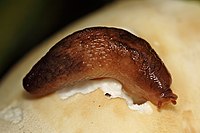
Photo from wikipedia
Pesticides of chemical synthesis have mainly been used to control pests, diseases and adventitious plants up until now. However, it has been shown that some pesticides can remain in the… Click to show full abstract
Pesticides of chemical synthesis have mainly been used to control pests, diseases and adventitious plants up until now. However, it has been shown that some pesticides can remain in the soil for long periods of time, thus affecting the development of organisms in the rhizosphere as well as human health, which are two of the most noteworthy side effects. The aim of this research was to analyze the compatibility of autochthonous Trichoderma strains with different synthetic fungicides, acaricides, insecticides (including an entomopathogenic fungus) and herbicides. Sulfur encouraged the growth of all autochthonous strains assayed, and the combination Trichoderma-B. bassiana did not disturb their growth. So, the combination of the autochthonous Trichoderma strains with these organic pesticides will be a positive strategy to apply in the field to control pests and some diseases. Conventional pesticides modified the development of all autochthonous Trichoderma strains, demonstrating that not only do they affect weeds, fungus or pests but also rhizosphere microorganisms. In conclusion, conventional pesticides indiscriminately used to control pests, diseases and weeds could reduce the development of autochthonous Trichoderma strains, especially fungicides and herbicides.
Journal Title: Journal of Fungi
Year Published: 2022
Link to full text (if available)
Share on Social Media: Sign Up to like & get
recommendations!